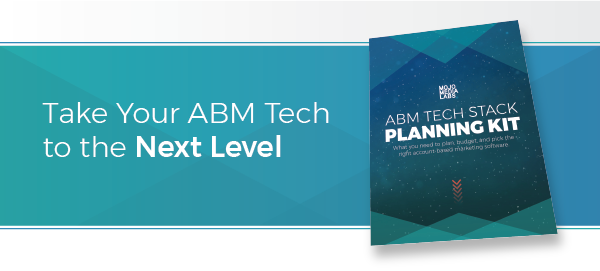Preparing Your Account-Based Marketing Technology Stack
There's something to be said for the benefits technology brings to marketing. It's no longer a game of letter writing, office visits, and dinners (though these are still part of an advanced ABM program). Technology is the key to ABM success because ABM is a strategic, scalable marketing program that requires optimal CRM, marketing automation, and other software to streamline your processes, manual and technology driven. That said, you can't buy your way into ABM success with technology. Over 6800 marketing technologies exist, but not all are best for your company. Today, we'll take a look at the five major technology categories that make up a solid account-based marketing tech stack and how each affects your organization's ABM success and business goals.
Account-Based Marketing Technology Categories
The five categories of technology that comprise and ABM tech stack relate to infrastructure, account selection, engagement, sales enablement, and measurement. Soon you'll understand what each category of technology solves for your business, who it affects, and see some examples of platforms falling under those categories.
1. Infrastructure
The pieces of infrastructure technology in ABM address the basic foundational aspects of your account-based marketing program needs. Your infrastructure technologies solve things like:
- Lead routing and prioritization
- Reporting on accounts
- Acting on accounts
- Bad data
Without your infrastructure pieces of technology in place, you cannot succeed in an account-based marketing program, plain and simple. It's the true foundation of your account-based marketing home, so to speak. These technology pieces affect the following roles:
- Marketing operations
- Sales operations
- Demand generation managers
- Website managers
- Content managers
- SDRs
They will be the key users for infrastructure technologies. Why? Because these technologies relate directly to their positions. The most basic infrastructure technologies include:
- CRM
- Marketing automation
- DMP
- CMS
- Tag management
- Live chat
It's pretty cut and dry when it comes to your infrastructure pieces because without these in place and functioning well for your account-based marketing program, there is no way to succeed. Customer data needs a place to live, your website content needs a home, and the very minimum of marketing automation should be set up to help you grow and scale strategically as ABM helps your organization hit its key business goals. While all technology components and categories are critical for account-based marketing success, you can only grow if you have solid infrastructure technologies in place with the teams capable of running them.
Need help planning your marketing technology stack?

2. Account Selection
Account-based marketing exists to target specific ideal customer profiles related to key accounts. As such, having the right account selection tools on hand from the start will help you hit goals and scale in the future. Account selection tools help your team address: Manual scaling difficulties, regular data updates, and need for better methods of combining data and practical knowledge.
It's in the name, and account-based marketing requires strategically chosen accounts to target in order to achieve the business goals while solving the issues mentioned above. The roles account selection tools will affect include:
- Marketing operations
- Sales operations
- Demand generation managers
- SDRs
They will have a primary role in building the initial target account list and continually iterating throughout the ABM program to address sales territory changes, product evolutions, and other adjustments affecting the list and its potential for success. Examples of account selection technologies are:
- Data append and management tools
- Predictive data tools
- Analytics tools
All of the above technologies help those in roles associated with target account selection choose the best fit accounts for the ABM program. It's critical to identify accounts similar to your best customers, and these tools give you the ability to scale. Also worth mentioning here is the importance of AI among account selection tools. AI and machine learning are key to helping you scale and expand your program to accounts beyond your current CRM or infrastructure database tools to maximize targeted efforts that will result in sales. Putting in the work up front for AI and machine learning pays off in future prioritization and scaling exercises with your target account list.
3. Engagement
As the name suggests, engagement tools help your program engage and connect with the best fit target accounts. Traditional marketing relies on spray and pray methods hoping for quantity over quality, but with an optimized target account list fueled by solid data and infrastructure technologies, targeted high touch engagement becomes much easier for all members of the ABM team. Some of the challenges engagement tools can help solve include:
- Difficulty reaching target accounts with pre-existing tactics
- Valuable segments not receiving targeted messaging
- Wasting money on non-ideal accounts
It's all about leveraging your current data from infrastructure and account selection tools to create the right messaging that meets the right accounts at the right time. Those roles involved in ensuring peak performance engagement include:
- Marketing operations
- Event managers
- Social media managers
- Field marketing
- Designers
- Demand generation managers
- Website managers
- In-house advertising managers
- Content managers
They will help create the appropriate messaging that will convert key accounts and ensure it reaches those accounts while enabling Sales along the way. Some examples of engagement technologies and tactics your company might use include:
- Advertising
- Social media
- Website
- Content
- Personalized messaging
- Events
Remember, ABM is high touch and high engagement with optimized, personalized messaging, so your ability to leverage your current data in your engagement tools and customer lifecycle understanding is critical. Creating engagement that spans digital tactics like personalized webpages and email alongside in-person events can make all the difference when getting a target account to convert to a customer.

4. Sales Enablement
While Marketing is mostly responsible for engagement tactics, there is a major component that can't be ignored, and that is Sales Enablement. When Sales has the tools it needs to convert potential customer accounts on the spot, the likelihood of success is much higher. Sales enablement tools help salespeople address:
- Ignored or cold leads
- Leads that aren't converting
It's critical in Sales Enablement technologies to invest in tools that address marketing and account activity, making it visible for Sales when they engage in conversations with target accounts. The roles affected, as you might have guessed, include:
- Marketing operations
- Sales operations
- Field marketing
- Demand generation managers
- SDRs
- Sales enablement managers
These roles help build the materials for Sales to use in the field and online, giving Sales the best methods to convert key accounts. A challenge with acquiring sales enablement technology comes with reaching the buying committee and convincing them the technology is worth the price. It's key to do your research and present them with a tool that enables contact development and enrichment as you scale your ABM program. Some tools that do this include:
- Contact development tools
- Account insight tools
- Sales intelligence tools
With these types of tools in your kit, Sales has a better chance of converting the right target accounts at the right time.
5. Measurement
With everything in account-based marketing, having tangible measured results and KPIs helps you see what's succeeding, what's not performing well, and where to scale. Measurement helps resolve challenges such as:
- Determining impact of campaigns
- Sharing accessible account insights and report with Sales
- Determining the messages that resonate most with target accounts
Measurement isn't a job for everyone in the ABM team. Those who have insights and ability to help create accessible reports all members of the organization can understand will have to steer the measurement ship to success. These roles include:
- Marketing operations
- Sales operations
- Demand generation managers
- SDRs
- Content managers
Because measurement is about gaining insights, it's important for these key roles to help build reports all members of the organization can read and learn from for future scaling practices. Measurement tools really boil down to the ability to resolve ignorance and allow people to see what's working by using account-based intelligence tools. These tools might include:
- Analytics tools
- Testing and optimization tools
- Business intelligence tools
- Attribution and reporting tools
Knowing which programs and activities make the most difference at different points of the account-based marketing program is the basis for any measurement tool, and generating reports to back up future decisions is critical for success.
Purchasing Account-Based Marketing Technology Tools
When discussing the pros and cons of technologies for your organization's account-based marketing program, you'll need to determine who will own the stack, create that team, train them on the value and use of the technologies, and put clear ROI metrics in place. Alignment is everything for ABM, and that's especially true when it comes to your organization's technology choices.
Your key considerations should relate to:
- Data
- Scalability
- Execution
- Cost
Your data creates insights that allow you to scale and execute at scale while adjusting your budget as needed. Again, you can't buy your way into a successful account-based marketing program, so even the most advanced technologies won't work if you don't have the teams and processes in place to perform. By finding solutions that check multiple boxes and the teams to keep them functioning well, your ABM technologies will allow data to communicate across platforms to keep your ABM program consistent and scalable from your basic CRM data to the advanced output reports on your most recent campaign tactics.




